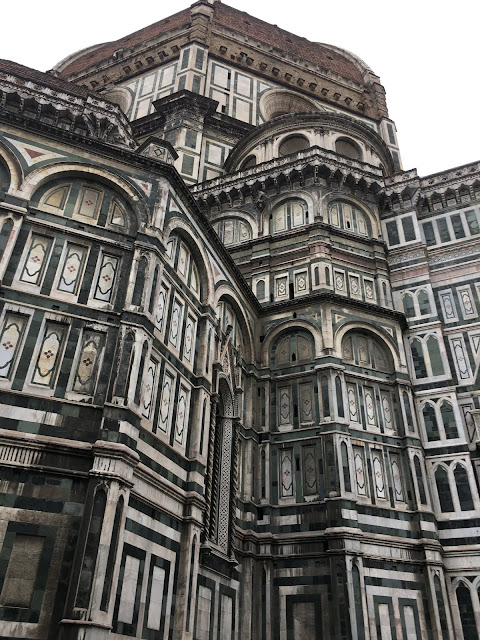One could spend the whole day walking and looking and still not see everything. I love beautiful art, but find myself feeling overwhelmed when there's so much in one place. The hallways between the gallery rooms are lined with sculptures, and rows of portraits hang just under the painted ceilings. Each piece on its own is magnificent.
What's striking is how much of the art is inspired by biblical and religious themes. Altarpieces from churches are numerous, and the theme of Mary with the Christ child is everywhere.
Some of the most well known pieces are Boticelli's Birth of Venus from c. 1485, and Spring from c. 1480.
The popular portraits of Martin Luther and his wife, Katharine von Bora by Lukas Cranach the Elder c. 1529 are also in the Uffizi. They were part of the Medici collection from 1567.
Windows here and there along the hallways open out to wonderful views of the Ponte Vecchio and the roofs of the city with the Duomo in the distance. In the first photo below, the lower long and narrow roof on the right is the "secret" passageway built by the Medici family to get between the Palazzo Vecchio, the Uffizi, and the Pitti Palace without being seen. It crosses the Ponte Vecchio (note the small windows at the top) and is about a kilometer in length. It's not open to the public today, but wouldn't it be fun to go through it?
The Tribune room is octagonal in shape and considered the heart of the Uffizi collections. It was built by Buontalenti at the request of Francesco I for Cosimo I de Medici to house his most valuable jewels and favorite pieces of art. Today, it is viewable only from the side doors. The walls were covered in red velvet fabric and the ceiling created using shells.
One of my favorite paintings at the Uffizi is by Giuseppe Maria Crespi from c. 1720 with the title Woman Washing the Dishes (The Scullery Maid). The blurb next to the painting says the painter "rejected academic precepts in favor of a more direct interpretation of reality." I like that.
We were fortunate to have a hotel right off Piazza della Repubblica, five minutes walk from the Duomo one direction, the Ponte Vecchio in another direction, the Palazzo Vecchio in a third direction, and ten minutes from the train station in a fourth direction.
The Duomo, also known as the Cathedral of Santa Maria del Fiore dominates the Florentine skyline. Built beginning in 1296 and designed by Arnolfo di Cambio, its famous dome designed by Filippo Brunelleschi was completed almost 200 years later. The church's exterior is made from white, pink, and green marble. Stunningly beautiful!
We chose not to pay the steep price to enter the baptistry or climb the cupola (something I did years ago), but I did take one shot of the Ghiberti's Eastern doors, called The Gates of Paradise -- called that because Michaelangelo is reported to have said, "They are so beautiful that they would be perfect for the gates of paradise."
This last painting of Saint Francis of Assisi reminds me of the beginning of the prayer
attributed to him:
Lord, make me an instrument of thy peace.
I wish you peace, pace, salam, and shalom


























No comments:
Post a Comment